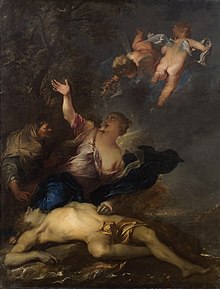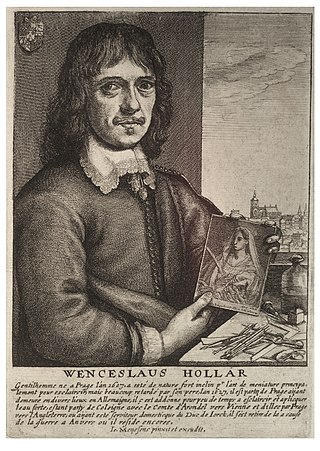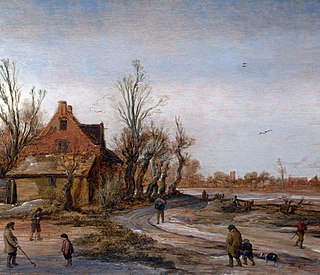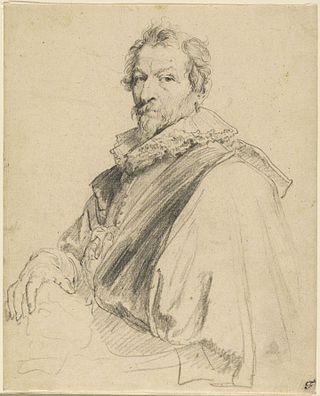
Gillis Backereel [1] (1572 - before 1662) [2] was a Flemish painter of history subjects. The artist was principally active in Antwerp where he produced various compositions for the local churches. [3]

Gillis Backereel [1] (1572 - before 1662) [2] was a Flemish painter of history subjects. The artist was principally active in Antwerp where he produced various compositions for the local churches. [3]
Gillis Backereel is believed to have been born in Antwerp in 1572. [3] There is no record of his training. He is known to have travelled to Italy where he resided in Rome. The dates are not known with certainty and estimates vary from prior to 1630, to the period between 1639 and 1643. [4] [5]
He became a master in the Antwerp Guild of St Luke in 1630. He lived a relatively quiet and secluded life. In 1651 he suddenly employed four apprentices including Dominicus de Beselaer the Elder and Frans de Hase. [4] [3] The latter was hired without pay in return for his training. A certain Francis de Crayer was also his pupil. [3]
Gillis had reportedly a much older brother called Willem Backereel who enjoyed a good reputation as a landscape painter and left young for Rome where he died young. [4] The early Dutch biographer Arnold Houbraken reported that the Backereel family produced a number of artists and that Joachim von Sandrart mentioned seven or eight Backereel family members that he knew personally. [6] Today Gillis is one of only three Backereel family members documented. The other two are Gillis' brother Willem Backereel and Jacques Backereel.

The date of Gillis' death is not recorded but is believed to have occurred between 1654 and 1662. [3]
Not many of Backereel's works have been preserved. They all depict religious and mythological subject matter.
His Adoration of the Shepherds and Vision of St. Felix are in the Royal Museums of Fine Arts of Belgium in Brussels and his Hero mourns the dead Leander in the Kunsthistorisches Museum in Vienna.
Backereel provided the design for an engraving by Wenceslaus Hollar representing Bruno of Cologne published in 1649. [7]

Wenceslaus Hollar was a prolific and accomplished Bohemian graphic artist of the 17th century, who spent much of his life in England. He is known to German speakers as Wenzel Hollar; and to Czech speakers as Václav Hollar. He is particularly noted for his engravings and etchings. He was born in Prague, died in London, and was buried at St Margaret's Church, Westminster.

Esaias van de Velde was a Dutch landscape painter.

Hendrick van Balen or Hendrick van Balen I was a Flemish Baroque painter and stained glass designer. Hendrick van Balen specialised in small cabinet pictures often painted on a copper support. His favourite themes were mythological and allegorical scenes and, to a lesser extent, religious subjects. The artist played an important role in the renewal of Flemish painting in the early 17th century and was one of the teachers of Anthony van Dyck.

Cornelis de Wael was a Flemish painter, engraver and merchant who was primarily active in Genoa in Italy. He is known for his genre paintings, battle scenes, history paintings and still lifes. Through his art work, support for Flemish painters working in Italy and role as an art dealer, he played an important role in the artistic exchange between Italy and Flanders in the first half of the 17th century. His work also had an influence on local painters such as Alessandro Magnasco, particularly through his scenes of despair and irony.

The Bentvueghels were a society of mostly Dutch and Flemish artists active in Rome from about 1620 to 1720. They are also known as the Schildersbent.

Maerten de Vos, Maerten de Vos the Elder or Marten de Vos was a Flemish painter. He is known mainly for his history and allegorical paintings and portraits. He was, together with the brothers Ambrosius Francken I and Frans Francken I, one of the leading history painters in the Spanish Netherlands after Frans Floris career slumped in the second half of the sixteenth century as a result of the Iconoclastic fury of the Beeldenstorm.

Cornelis Schut was a Flemish painter, draughtsman, engraver and tapestry designer who specialized in religious and mythological scenes. Presumed to have trained under Rubens, he treated Counter-Reformation subjects in a High-Baroque style. After a stay in Italy, he worked mainly in Antwerp where he was one of the leading history painters in the first half of the 17th century.

Jacob Foppens van Es, Jacob Fopsen van Es or Jacob van Es was a Flemish Baroque painter known for his still lifes mainly of food and occasionally flower paintings. He collaborated with other artists on garland paintings. Together with Osias Beert and Clara Peeters, he was one of the leading representatives of the first generation in Flemish still-life painting.

Jan Peeters the Elder or Johannes Peeters was a Flemish Baroque painter and draughtsman. He is known for his seascapes often depicting stormy seas and shipwrecks as well as for his topographical drawings, many of which were engraved by contemporary printmakers and published by the Antwerp printers.

Lodewijk de Vadder was a Flemish Baroque landscape painter, draughtsman, engraver and tapestry designer. His landscapes represent a move away from the Mannerist tradition of landscapes painting in Flemish art towards a more naturalistic approach exemplified by looser brushwork and an emphasis on atmospheric effects. He was the first Flemish landscape painter who painted dune landscapes as the primary feature of his landscapes. While his loose brush handling shows the influence of Rubens and Adriaen Brouwer, his restrained palette shows his awareness of developments in the Dutch Republic.

Marten Pepijn was a Flemish painter who was mainly known for his large-scale history paintings and to a lesser extent for his smaller genre scenes.

Lucas de Wael was a Flemish painter, art dealer and merchant. He was born in Antwerp and worked for some time in Genoa in Italy before returning to Antwerp. Here he continued his artistic and commercial activities. He is known for his landscapes and genre scenes.

Carel van Savoyen or Carel van Savoy (1620/21–1665) was a Flemish painter, draughtsman and printmaker who was active in Antwerp and Amsterdam. He is mainly known for his history paintings and portraits but he also painted allegories and genre scenes.

Abraham Genoels II or Abraham Genouil was a Flemish Baroque painter, draughtsman, engraver and tapestry designer. He is now mainly known for his landscape paintings, drawings and prints. He had an international career that saw him work in Paris, Rome and Antwerp.

Anton Goubau or Anton Goebouw was a Flemish Baroque painter. He spent time in Rome where he moved in the circle of the Bamboccianti, Dutch and Flemish genre painters who created small cabinet paintings of the everyday life of the lower classes in Rome and its countryside. He is known for his Italianate landscapes and genre paintings in the style of the Bamboccianti and his history paintings with mythological and religious themes.

Leo van Heil, was a Flemish architect, painter and miniature painter mainly of flowers and insects. He is chiefly remembered for his designs of the Brigittines chapel and the tower of the Saint Nicholas Church, both in Brussels.

Jacob Ferdinand Voet or Jakob Ferdinand Voet was a Flemish portrait painter. He had an international career that brought him to Italy and France, where he made portraits for an elite clientele. Voet is regarded as one of the best and most fashionable portrait painters of the High Baroque.
Guiliam or Willem Backereel, was a Flemish Baroque landscape painter.

Franciscus de Neve (II) (also: Frans de (II) Neve, Fraciscus de Neuff, Francesco della Neve and nicknames: Bloosaerken and Blaserken) (1632, Antwerp – after 1704) was a Flemish painter and engraver. He is known for his late Baroque religious and mythological scenes and landscapes. He had an international career in Italy, Southern Germany and Austria where he worked for aristocratic patrons and churches; He returned to his native Flanders later in his life.